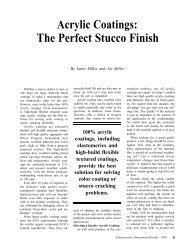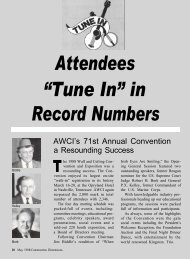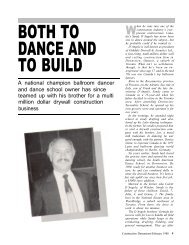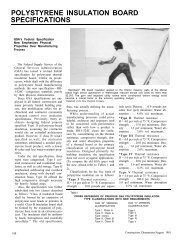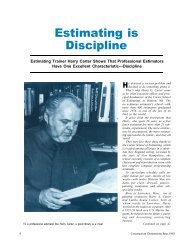The Real Cost Of Overtime - AWCI
The Real Cost Of Overtime - AWCI
The Real Cost Of Overtime - AWCI
Create successful ePaper yourself
Turn your PDF publications into a flip-book with our unique Google optimized e-Paper software.
<strong>The</strong> <strong>Real</strong> <strong>Cost</strong> <strong>Of</strong> <strong>Overtime</strong><br />
Special study on long hours for protracted periods<br />
demonstrates the inevitable—It’s expensive<br />
That continued overtime produces<br />
a decline in productivity comes as no<br />
great surprise to a professional wall<br />
and ceiling contractor.<br />
Study after study has demonstrated<br />
that continued overtime has a<br />
measurable impact on fatigue and<br />
morale.<br />
But a recent study compiled by<br />
<strong>The</strong> Business Roundtable gives some<br />
interesting insights into the effect of<br />
scheduled overtime over a protracted<br />
period.<br />
Previous overtime studies in construction<br />
have shown that:<br />
• When field construction operations<br />
on a big project are put on a<br />
scheduled overtime basis it can disrupt<br />
the local construction economy,<br />
it can disrupt the local construction<br />
economy, reduce labor productivity,<br />
and ultimately produce excessive inflation<br />
in construction costs.<br />
• With a work schedule of 40 or<br />
more hours per week for two months<br />
or more, the cumulative effect of<br />
decreased productivity will cause a<br />
delay in the completion date beyond<br />
that which could have been realized<br />
with the same crew size on a 40-hour<br />
week<br />
• Proper management can minimize<br />
the inflationary effects where overtime<br />
operations are deemed absolutely<br />
necessary despite predictable productivity<br />
losses— for example, on a<br />
remote construction site where bachelor<br />
housing is provided or on maintenance<br />
turnarounds. As for studies<br />
on the effect in construction of<br />
morale and fatigue, data confirms<br />
what most wall and ceiling contractors<br />
already know:<br />
• <strong>The</strong> longer the hours, the more<br />
scheduled work time will be lost<br />
through absenteeism.<br />
• Injuries increase as hours increase,<br />
not only in absolute numbers, but<br />
also in rate of incidence<br />
• For hours above eight (8) per day<br />
and 48 per week, it usually took three<br />
hours of work to produce two addi-<br />
14 Construction Dimensions/July 1981
“When a subcontractor sits down and computes the premium<br />
cost for overtime hours . . . he is often astounded with the<br />
almost unreasonable inflation of the unit labor cost.”<br />
tional hours of output when the<br />
work was light. For heavy work, it<br />
took two hours to produce one hour<br />
of additional output.<br />
Using this data, as an example,<br />
statisticians found that four weeks of<br />
eight hours per day produced a productive<br />
efficiency of 16 percent advantage<br />
over four weeks of nine<br />
hours per day.<br />
This study was done in a manufacturing<br />
facility, and when the same<br />
test pattern was conducted on a crew<br />
of carpenters the productivity differential<br />
was found to be nearly 20 percent.<br />
Also, when operations are scheduled<br />
on a seven-day basis, the productivity<br />
for the entire week was<br />
substantially less than when workers<br />
enjoyed an “off Sunday.”<br />
<strong>The</strong> findings that have been discussed<br />
above are all derived from<br />
studies made for short period overtime<br />
work. <strong>The</strong> new Roundtable<br />
study was performed on longer periods<br />
of time.<br />
In this way, should a wall and ceiling<br />
contractor become involved in a<br />
project requiring scheduled overtime<br />
for a longer period of time, he may<br />
be forewarned of consequences which<br />
impact not only on his own work<br />
pace and crews but the impact on<br />
other subs and trades as well.<br />
Consequently, no matter how efficient<br />
and competent are the wall and<br />
ceiling contractor’s management and<br />
supervision, should the other trades<br />
fall behind in schedule through productivity<br />
inefficiencies, the wall and<br />
ceiling contractor will be dragged into<br />
the falloff.<br />
Immediate Effects<br />
From Big Projects<br />
When a project in an area is put on<br />
a scheduled overtime basis, a series<br />
of problems immediately develop.<br />
<strong>The</strong> movement of workers from<br />
other projects in the area to the over-<br />
Construction Dimensions/ July 1981<br />
15
time job creates somewhat of an<br />
“auction” atmosphere.<br />
Other jobs need to go on overtime<br />
to hold their labor, and a bidding<br />
process is actually developed. <strong>The</strong><br />
local labor supply, being fairly constant,<br />
combines with the additional<br />
productive capacity of transient<br />
workers—but is still offset by the<br />
reduced productivity caused by overtime.<br />
Too, a major portion of the increase<br />
in numbers of workers in the<br />
affected area is represented by permit<br />
workers in the crafts who are less<br />
proficient or poorly qualified.<br />
This latter group creates disruptions<br />
and the lesser skills is amplified<br />
by longer working hours, increased<br />
absenteeism, and reduced effectiveness<br />
due to fatigue. <strong>The</strong> “strong as<br />
the weakest link” theory takes over<br />
and the entire project suffers.<br />
Data shows that on extended overtime,<br />
in cases such as the one cited<br />
above, the reduced productivity of<br />
workers for a week’s work is equal to<br />
16<br />
Construction Dimensions/ July 1981
“. . . a craftsman learns to expend his physical and mental energy<br />
at an accepted pace which he has established<br />
over long periods of adaptation.”<br />
or greater than the number of overtime<br />
hours worked.<br />
When a subcontractor sits down<br />
and computes the premium cost for<br />
overtime hours—he is often astounded<br />
with the almost unreasonable inflation<br />
of the unit labor cost. Yet<br />
these stark and easily counted costs<br />
are further effected by time, local<br />
labor climate, management actions,<br />
and job locations—all of which can<br />
influence the final unit labor cost.<br />
As an example, it is well known<br />
that within narrow limits a craftsman<br />
learns to expend his physical and<br />
mental energy at an accepted pace<br />
which he has established over long<br />
periods of adaptation.<br />
When the hours of work per day<br />
or per week are changed and extended—even<br />
for a short period (and this<br />
does not include putting in a few<br />
hours of overtime to finish up a tem-<br />
Construction Dimensions/ July 1981<br />
porary task—there is an inevitable<br />
adjustment period.<br />
Studies reveal that scheduled overtime<br />
operations result in a sharp drop<br />
in productivity initially, followed by<br />
a fairly substantial recovery by the<br />
end of the first week. <strong>The</strong> recovery<br />
level of productivity may then hold<br />
fairly steady for a period of two to<br />
three weeks but show a steady decline<br />
for the following two to three weeks.<br />
After five to six weeks of operations,<br />
there is a further drop in productivity<br />
which levels out at a low<br />
point after nine to twelve weeks of<br />
sustained overtime operation.<br />
This adjusting to a new work/time<br />
level, it should be understood, results<br />
from normal human reactions. It<br />
does not reflect the impact of additional<br />
adverse ‘factors such as labor,<br />
climate, and perhaps poor management.<br />
Where work in excess of 40 hours<br />
per week is necessary, there are a<br />
variety of alternative or remedial actions<br />
which should be considered.<br />
<strong>The</strong>se, of course, depend on the circumstances,<br />
but they include:<br />
• Employment of additional shifts—<br />
two or three shifts are often more<br />
productive than extended overtime.<br />
• Use of an additional crew to provide<br />
scheduled time off without work<br />
interruptions (e.g., each man works<br />
14 days, then off seven days, as is<br />
common on offshore platform<br />
work).<br />
• Where work is scheduled seven<br />
days/week, periodic shutdown of the<br />
work over a Sunday or weekend—<br />
productivity benefits may more than<br />
offset the lost working time. (Figure<br />
8 illustrates the effect of this on a<br />
project on a 70 hours/week schedule).<br />
17




